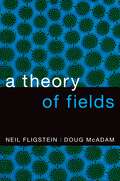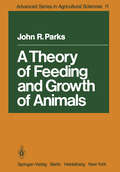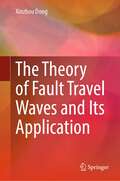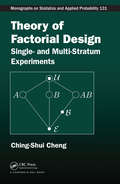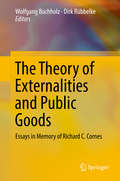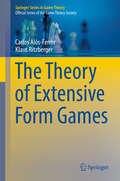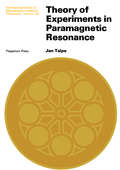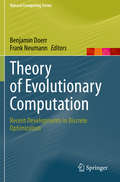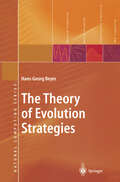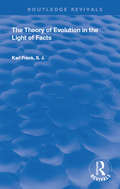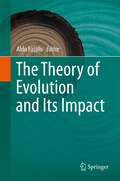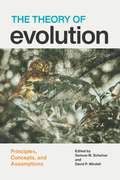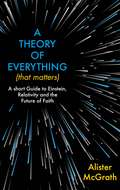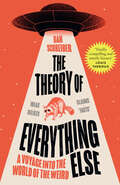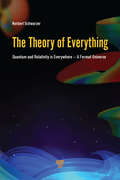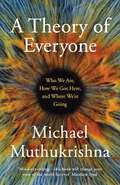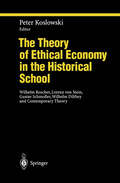- Table View
- List View
A Theory of Fields
by Neil Fligstein Doug McAdamFinding ways to understand the nature of social change and social order-from political movements to market meltdowns-is one of the enduring problems of social science. A Theory of Fields draws together far-ranging insights from social movement theory, organizational theory, and economic and political sociology to construct a general theory of social organization and strategic action. In a work of remarkable synthesis, imagination, and analysis, Neil Fligstein and Doug McAdam propose that social change and social order can be understood through what they call strategic action fields. They posit that these fields are the general building blocks of political and economic life, civil society, and the state, and the fundamental form of order in our world today. Similar to Russian dolls, they are nested and connected in a broader environment of almost countless proximate and overlapping fields. Fields are mutually dependent; change in one often triggers change in another. At the core of the theory is an account of how social actors fashion and maintain order in a given field. This sociological theory of action, what they call "social skill," helps explain what individuals do in strategic action fields to gain cooperation or engage in competition. To demonstrate the breadth of the theory, Fligstein and McAdam make its abstract principles concrete through extended case studies of the Civil Rights Movement and the rise and fall of the market for mortgages in the U.S. since the 1960s. The book also provides a "how-to" guide to help others implement the approach and discusses methodological issues. With a bold new approach, A Theory of Fields offers both a rigorous and practically applicable way of thinking through and making sense of social order and change-and how one emerges from the other-in modern, complex societies.
Theory of Fermi-liquids in Metals: A Compact Overview as an Introduction to Theoretical Solid-State Physics (essentials)
by Michael KinzaThis essential offers a compact introduction to the theory of Fermi liquid for physics students in their main studies. It forms the basis for an understanding of theoretical solid state physics and is part of every introductory lecture on this topic. After a brief overview of the Sommerfeld model of metals, the concept of the quasiparticle is introduced. Important calculations characterizing a Fermi liquid are derived in detailed calculations. The essential concludes with an overview of the microscopic theory of Fermi liquids.This Springer essential is a translation of the original German 1st edition essentials, Theorie der Fermiflüssigkeit in Metallen by Michael Kinza, published by Springer Fachmedien Wiesbaden GmbH, part of Springer Nature in 2018. The translation was done with the help of artificial intelligence (machine translation by the service DeepL.com). A subsequent human revision was done primarily in terms of content, so that the book will read stylistically differently from a conventional translation. Springer Nature works continuously to further the development of tools for the production of books and on the related technologies to support the authors.
A Theory of Feeding and Growth of Animals (Advanced Series in Agricultural Sciences #11)
by John R ParksGeoffrey R. Dolby, PhD One of the principal characteristics of a scientific theory is that it be falsifiable. It must contain predictions about the real world which can be put to experimental test. Another very important characteristic of a good theory is that it should take full cognisance of the literature of the discipline in which it is embedded, and that it should be able to explain, at least as well as its competitors, those experimental results which workers in the discipline accept without dispute. Readers of John Parks' book will be left in no doubt that his theory of the feeding and growth of animals meets both of the above criteria. The author's knowledge of the literature of animal science and the seriousness of his attempt to incorporate the results of much previous work into the framework of the present theory result in a rich and imaginative integration of diverse material concerned with the growth and feeding of animals through time, a theory which is made more precise through the judicious use of mathematics. The presentation is such that the key concepts are introduced gradually and readers not accustomed to a mathematical treatment will find that they can appreciate the ideas without undue trauma. The key concepts are clearly illustrated by means of a generous set of figures. The crux of the theory comprises three differential Eqs. (7. 1-7.
The Theory of Fault Travel Waves and Its Application
by Xinzhou DongThe book starts from the existed problems in fault analysis of the lumped-parameter circuit model. It firstly introduces the basic electromagnetic phenomenon, uniform transmission line guided electromagnetic waves, multi-conductor system guided electromagnetic waves, fault generated travelling waves; then it introduces series of the traveling waves based protections, which includes principle, technology and application in practical power grid; it also discusses the travelling waves based fault location and the travelling waves based fault feeder selector in China. It systemically reveals the essential features of the fault traveling wave and concludes the analytical solutions of the transient fault traveling waves and the modulus maxima representation of the dyadic wavelet transform of fault traveling waves. Finally, the book analyzes the acquisition of traveling waves and the sensor’s characteristics. A unique fault travelling wave test device has been invented based on the theories of the book and will be applied in real systems.
Theory of Factorial Design: Single- and Multi-Stratum Experiments
by Ching-Shui ChengBringing together both new and old results, Theory of Factorial Design: Single- and Multi-Stratum Experiments provides a rigorous, systematic, and up-to-date treatment of the theoretical aspects of factorial design. To prepare readers for a general theory, the author first presents a unified treatment of several simple designs, including completely
The Theory of Externalities and Public Goods: Essays in Memory of Richard C. Cornes
by Wolfgang Buchholz Dirk RübbelkeThis state-of-the art collection of papers analyses various aspects of the theory of externalities and public goods. The contributions employ new analytical techniques like the aggregative game approach, and discuss the philosophical underpinnings of the theory. Furthermore, they highlight a range of topical empirical applications including climate policy and counterterrorism. This contributed volume was written in memory of Richard C. Cornes, a pioneer in the theory of externalities and public goods.
The Theory of Extensive Form Games (Springer Series in Game Theory)
by Carlos Alós-Ferrer Klaus RitzbergerThis book treats extensive form game theory in full generality. It provides a framework that does not rely on any finiteness assumptions at all, yet covers the finite case. The presentation starts by identifying the appropriate concept of a game tree. This concept represents a synthesis of earlier approaches, including the graph-theoretical and the decision-theoretical ones. It then provides a general model of sequential, interpersonal decision making, called extensive decision problems. Extensive forms are a special case thereof, which is such that all strategy profiles induce outcomes and do so uniquely. Requiring the existence of immediate predecessors yields discrete extensive forms, which are still general enough to cover almost all applications. The treatment culminates in a characterization of the topologies on the plays of the game tree that admit equilibrium analysis.
Theory of Experiments in Paramagnetic Resonance: International Series of Monographs in Natural Philosophy
by Jan TalpeInternational Series of Monographs in Natural Philosophy, Volume 33: Theory of Experiments in Paramagnetic Resonance discusses the technique for studying materials with unpaired electrons. This book is divided into four chapters. Chapter 1 provides a general introduction to examining matter through applying a magnetic field. The paramagnetic resonance line, such as the HF susceptibility as a function of certain parameters, is analyzed in the next chapter. Chapter 3 deals with the electronic signal that produces the HF susceptibility. The last chapter is devoted to the enhancement of the electronic signal above noise. This volume is beneficial to chemists and students interested in paramagnetic resonance.
Theory of Evolutionary Computation: Recent Developments in Discrete Optimization (Natural Computing Series)
This edited book reports on recent developments in the theory of evolutionary computation, or more generally the domain of randomized search heuristics. It starts with two chapters on mathematical methods that are often used in the analysis of randomized search heuristics, followed by three chapters on how to measure the complexity of a search heuristic: black-box complexity, a counterpart of classical complexity theory in black-box optimization; parameterized complexity, aimed at a more fine-grained view of the difficulty of problems; and the fixed-budget perspective, which answers the question of how good a solution will be after investing a certain computational budget. The book then describes theoretical results on three important questions in evolutionary computation: how to profit from changing the parameters during the run of an algorithm; how evolutionary algorithms cope with dynamically changing or stochastic environments; and how population diversity influences performance. Finally, the book looks at three algorithm classes that have only recently become the focus of theoretical work: estimation-of-distribution algorithms; artificial immune systems; and genetic programming. Throughout the book the contributing authors try to develop an understanding for how these methods work, and why they are so successful in many applications. The book will be useful for students and researchers in theoretical computer science and evolutionary computing.
The Theory of Evolution Strategies (Natural Computing Series)
by Hans-Georg BeyerEvolutionary algorithms, such as evolution strategies, genetic algorithms, or evolutionary programming, have found broad acceptance in the last ten years. In contrast to its broad propagation, theoretical analysis in this subject has not progressed as much. This monograph provides the framework and the first steps toward the theoretical analysis of Evolution Strategies (ES). The main emphasis is deriving a qualitative understanding of why and how these ES algorithms work.
The Theory of Evolution in the Light of Facts (Routledge Revivals)
by Karl FrankPublished in 1913: The object of the present work is to throw some light on the theory of Descent. Among many of the students of nature of the present day we perceive that greater and greater contradictions arise between the actual results of their technical work and that which they put forward as ‘postulates’ of the theory of Evolution.
The Theory of Evolution in the Light of Facts (Routledge Revivals)
by Karl FrankPublished in 1913: The object of the present work is to throw some light on the theory of Descent. Among many of the students of nature of the present day we perceive that greater and greater contradictions arise between the actual results of their technical work and that which they put forward as ‘postulates’ of the theory of Evolution.
The Theory of Evolution and Its Impact
by Aldo FasoloYear 2009 was the triumph of Darwin as a global superstar, spinning from the pop icon to the actual understanding to what make him a great innovator, able to give a turn to whole modern culture. Does all this activity mean evolution has lost its ability to excite fear and opposition? After such a deluge of books, conferences, reviews, gadgets, what is today our vision on theory of Evolution and its Impact? These are the questions asked at an inter-academy conference held in Torino (May 27-29, 2010) among the Accademia delle Scienze di Torino, the Accademia Nazionale dei Lincei and the Berlin-Brandenburgische Akademie der Wissenschaften. The present book collects the contributions from the meeting, mixing styles, arguments, topics, history and philosophy of science, modern biology and epistemology . This kind of inter-disciplinary approach may appear erratic, but it conveys flashes of lights on the changing scene where the theory of evolution plays. This is in line with the idea to reopen the file of the Two Cultures, looking at shared problems, which are not yet really the Third Culture invoked by Charles Percy Snow half a century ago, but they can foster it, at least in such a pivotal domain as evolution. According to the philosopher Michael Ruse, the conclusion is “that in fifty years or a hundred years we will still have the theory of the Origin around. Great, precisely because it does not stand still, but remakes itself and grows and changes by virtue of the fact that it gives such a terrific foundation. Is Darwinism past its sell-by date? Not by a long chalk yet!”
The Theory of Evolution: Principles, Concepts, and Assumptions
by Samuel M. Scheiner David A. MindellDarwin’s nineteenth-century writings laid the foundations for modern studies of evolution, and theoretical developments in the mid-twentieth century fostered the Modern Synthesis. Since that time, a great deal of new biological knowledge has been generated, including details of the genetic code, lateral gene transfer, and developmental constraints. Our improved understanding of these and many other phenomena have been working their way into evolutionary theory, changing it and improving its correspondence with evolution in nature. And while the study of evolution is thriving both as a basic science to understand the world and in its applications in agriculture, medicine, and public health, the broad scope of evolution—operating across genes, whole organisms, clades, and ecosystems—presents a significant challenge for researchers seeking to integrate abundant new data and content into a general theory of evolution. This book gives us that framework and synthesis for the twenty-first century. The Theory of Evolution presents a series of chapters by experts seeking this integration by addressing the current state of affairs across numerous fields within evolutionary biology, ranging from biogeography to multilevel selection, speciation, and macroevolutionary theory. By presenting current syntheses of evolution’s theoretical foundations and their growth in light of new datasets and analyses, this collection will enhance future research and understanding.
The Theory of Evolution: Principles, Concepts, and Assumptions
by Samuel M. Scheiner David P. MindellDarwin’s nineteenth-century writings laid the foundations for modern studies of evolution, and theoretical developments in the mid-twentieth century fostered the Modern Synthesis. Since that time, a great deal of new biological knowledge has been generated, including details of the genetic code, lateral gene transfer, and developmental constraints. Our improved understanding of these and many other phenomena have been working their way into evolutionary theory, changing it and improving its correspondence with evolution in nature. And while the study of evolution is thriving both as a basic science to understand the world and in its applications in agriculture, medicine, and public health, the broad scope of evolution—operating across genes, whole organisms, clades, and ecosystems—presents a significant challenge for researchers seeking to integrate abundant new data and content into a general theory of evolution. This book gives us that framework and synthesis for the twenty-first century. The Theory of Evolution presents a series of chapters by experts seeking this integration by addressing the current state of affairs across numerous fields within evolutionary biology, ranging from biogeography to multilevel selection, speciation, and macroevolutionary theory. By presenting current syntheses of evolution’s theoretical foundations and their growth in light of new datasets and analyses, this collection will enhance future research and understanding.
The Theory of Evolution: Principles, Concepts, and Assumptions
by Samuel M. Scheiner David P. MindellDarwin’s nineteenth-century writings laid the foundations for modern studies of evolution, and theoretical developments in the mid-twentieth century fostered the Modern Synthesis. Since that time, a great deal of new biological knowledge has been generated, including details of the genetic code, lateral gene transfer, and developmental constraints. Our improved understanding of these and many other phenomena have been working their way into evolutionary theory, changing it and improving its correspondence with evolution in nature. And while the study of evolution is thriving both as a basic science to understand the world and in its applications in agriculture, medicine, and public health, the broad scope of evolution—operating across genes, whole organisms, clades, and ecosystems—presents a significant challenge for researchers seeking to integrate abundant new data and content into a general theory of evolution. This book gives us that framework and synthesis for the twenty-first century. The Theory of Evolution presents a series of chapters by experts seeking this integration by addressing the current state of affairs across numerous fields within evolutionary biology, ranging from biogeography to multilevel selection, speciation, and macroevolutionary theory. By presenting current syntheses of evolution’s theoretical foundations and their growth in light of new datasets and analyses, this collection will enhance future research and understanding.
The Theory of Evolution: Principles, Concepts, and Assumptions
by Samuel M. Scheiner David P. MindellDarwin’s nineteenth-century writings laid the foundations for modern studies of evolution, and theoretical developments in the mid-twentieth century fostered the Modern Synthesis. Since that time, a great deal of new biological knowledge has been generated, including details of the genetic code, lateral gene transfer, and developmental constraints. Our improved understanding of these and many other phenomena have been working their way into evolutionary theory, changing it and improving its correspondence with evolution in nature. And while the study of evolution is thriving both as a basic science to understand the world and in its applications in agriculture, medicine, and public health, the broad scope of evolution—operating across genes, whole organisms, clades, and ecosystems—presents a significant challenge for researchers seeking to integrate abundant new data and content into a general theory of evolution. This book gives us that framework and synthesis for the twenty-first century. The Theory of Evolution presents a series of chapters by experts seeking this integration by addressing the current state of affairs across numerous fields within evolutionary biology, ranging from biogeography to multilevel selection, speciation, and macroevolutionary theory. By presenting current syntheses of evolution’s theoretical foundations and their growth in light of new datasets and analyses, this collection will enhance future research and understanding.
The Theory of Evolution: Principles, Concepts, and Assumptions
by Samuel M. Scheiner David P. MindellDarwin’s nineteenth-century writings laid the foundations for modern studies of evolution, and theoretical developments in the mid-twentieth century fostered the Modern Synthesis. Since that time, a great deal of new biological knowledge has been generated, including details of the genetic code, lateral gene transfer, and developmental constraints. Our improved understanding of these and many other phenomena have been working their way into evolutionary theory, changing it and improving its correspondence with evolution in nature. And while the study of evolution is thriving both as a basic science to understand the world and in its applications in agriculture, medicine, and public health, the broad scope of evolution—operating across genes, whole organisms, clades, and ecosystems—presents a significant challenge for researchers seeking to integrate abundant new data and content into a general theory of evolution. This book gives us that framework and synthesis for the twenty-first century. The Theory of Evolution presents a series of chapters by experts seeking this integration by addressing the current state of affairs across numerous fields within evolutionary biology, ranging from biogeography to multilevel selection, speciation, and macroevolutionary theory. By presenting current syntheses of evolution’s theoretical foundations and their growth in light of new datasets and analyses, this collection will enhance future research and understanding.
The Theory of Evolution: Principles, Concepts, and Assumptions
Darwin’s nineteenth-century writings laid the foundations for modern studies of evolution, and theoretical developments in the mid-twentieth century fostered the Modern Synthesis. Since that time, a great deal of new biological knowledge has been generated, including details of the genetic code, lateral gene transfer, and developmental constraints. Our improved understanding of these and many other phenomena have been working their way into evolutionary theory, changing it and improving its correspondence with evolution in nature. And while the study of evolution is thriving both as a basic science to understand the world and in its applications in agriculture, medicine, and public health, the broad scope of evolution—operating across genes, whole organisms, clades, and ecosystems—presents a significant challenge for researchers seeking to integrate abundant new data and content into a general theory of evolution. This book gives us that framework and synthesis for the twenty-first century. The Theory of Evolution presents a series of chapters by experts seeking this integration by addressing the current state of affairs across numerous fields within evolutionary biology, ranging from biogeography to multilevel selection, speciation, and macroevolutionary theory. By presenting current syntheses of evolution’s theoretical foundations and their growth in light of new datasets and analyses, this collection will enhance future research and understanding.
A Theory of Everything (That Matters): A Short Guide to Einstein, Relativity and the Future of Faith
by Alister McGrathOn 29th May 1919, British astronomers tested Einstein's theory of relativity by measuring the path of the stars travelling near the sun during an eclipse. On 7th November 1919, the results of that experiment were announced in London, proving Einstein's theory of relativity. A Theory of Everything (that Matters) has been written in celebration of this 100th anniversary. With the confirmation of Einstein's theories at the beginning of the twentieth century, our understanding of the universe became much more complex. What does this mean for religious belief, and specifically Christianity? Does it mean, as so many people assume, the death of God? In A Theory of Everything (that Matters) Alister McGrath - Professor of Science and Religion at Oxford University - explores these questions, giving an overview of Einstein's thought and scientific theories, including his nuanced thinking on the difference between the scientific enterprise and beliefs outside its realm. This groundbreaking book is for anyone intrigued by Einstein as one of the twentieth century's most iconic figures, who wants to know what his theories mean for religion, and who is interested in the conversation between science and religions more broadly.'An excellent study of Einstein's theories in relation to his beliefs about God' - starred review in PUBLISHERS WEEKLY
The Theory of Everything Else
by Dan SchreiberThis is not a book of facts; it’s a book of ‘facts’. Should you finish it believing we became the planet’s dominant species because predators found us too smelly to eat; or that the living bloodline of Christ is a family of Japanese garlic farmers – well, that’s on you. Why are we here? Do ghosts exist? Did life on Earth begin after a badly tidied-up picnic? Was it just an iceberg that sank the Titanic? Are authors stealing their plotlines from the future? Will we ever talk to animals? And why, when you’re in the shower, does the shower curtain always billow in towards you? We don’t know the answers to any of these questions. But don’t worry, no matter what questions you have, you can bet on the fact that there is someone (or something) out there, investigating it on your behalf. From the sports stars who use cosmic energy to office plants investigating murders, The Theory of Everything Else will act as a handbook for those who want to think differently.
The Theory of Everything: Quantum and Relativity is everywhere – A Fermat Universe
by Norbert SchwarzerThe book unifies quantum theory and the general theory of relativity. As an unsolved problem for about 100 years and influencing so many fields, this is probably of some importance to the scientific community. Examples like Higgs field, limit to classical Dirac and Klein–Gordon or Schrödinger cases, quantized Schwarzschild, Kerr, Kerr–Newman objects, and the photon are considered for illustration. An interesting explanation for the asymmetry of matter and antimatter in the early universe was found while quantizing the Schwarzschild metric.
The Theory of Everything: Quantum and Relativity is everywhere – A Fermat Universe
by Norbert SchwarzerThe book unifies quantum theory and the general theory of relativity. As an unsolved problem for about 100 years and influencing so many fields, this is probably of some importance to the scientific community. Examples like Higgs field, limit to classical Dirac and Klein–Gordon or Schrödinger cases, quantized Schwarzschild, Kerr, Kerr–Newman objects, and the photon are considered for illustration. An interesting explanation for the asymmetry of matter and antimatter in the early universe was found while quantizing the Schwarzschild metric.
A Theory of Everyone: Who We Are, How We Got Here, and Where We’re Going
by Michael Muthukrishna'Mind expanding - this book will change your view of the world forever' Matthew Syed'Wonderfully refreshing and thought-provoking' Peter Frankopan'Original, fascinating, and provocative' Andrew McAfeeA blueprint for a better future. Playing on the phrase "a theory of everything" in physics, Michael Muthukrishna offers a unified theory of human behavior, culture, and society - a theory of everyone.Drawing on the most recent research across the sciences, humanities, and the emerging field of cultural evolution, he paints a panoramic picture of who we are and exactly what makes human beings different from all other forms of life on the planet.Muthukrishna argues that it is our unique ability to create culture, a shared body of knowledge, skills, and experience passed on from generation to generation that has enabled our current dominance. But it is only by understanding and applying the laws of life - the need for energy, innovation, cooperation and evolution - that we can solve the practical and existential challenges we face as a species.A Theory of Everyone attempts to provide solutions for how to solve the most pressing problems of our collective future, such as polarization, inequality, the "great stagnation" in productivity, and the energy crisis. Casting a bold and ambitious net, this is a must-read for anyone interested in a better future for ourselves and generations to come.
